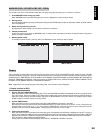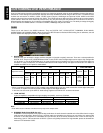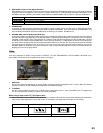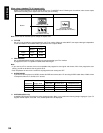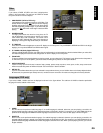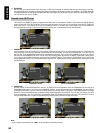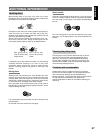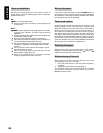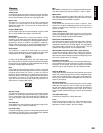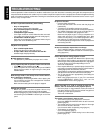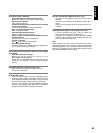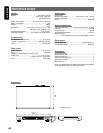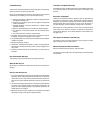
ENGLISH
39
Glossary
Analog audio
An electrical signal that directly represents sound. Compare
this to digital audio which can be an electrical signal, but is an
indirect representation of sound. See also Digital audio.
Aspect ratio
The width of a TV screen relative to its height. Conventional
TVs are 4:3 (in other words, the screen is almost square);
widescreen models are 16:9 (the screen is almost twice as
wide as it is high).
Chapter (DVD-Video)
Just as a book is split up into several chapters, a title on a DVD
disc is usually divided into chapters. See also Title.
Digital audio
An indirect representation of sound by numbers. During
recording, the sound is measured at discrete intervals (44,100
times a second for CD audio) by an analog-todigital converter,
generating a stream of numbers. On playback, a digital-to-
analog converter generates an analog signal based on these
numbers. See also Sampling frequency and Analog audio.
Dolby Digital
The maximum 5.1 channels of audio used in the surround
system (Surround Digital) for movie theaters is digital data
compressed by the third generation algorithm encoder.
1
MP3
MP3 (MPEG1 audio layer 3) is a compressed audio file format.
Files are recognized by their file extension “.mp3” or “.MP3”.
MPEG video
The video format used for Video CDs and DVDs. Video CD
uses the older MPEG-1 standard, while DVD uses the newer
and much better quality MPEG-2 standard.
Multi-session
A CD-R/RW that contains two or more ‘sessions’. Each
session is a complete recording process, so each session is
read as a complete disc. This player can only read the first
session on a disc.
Optical digital output
A jack that outputs digital audio in the form of light pulses.
Connect components with optical digital jacks using a special
optical cord, available from good audio dealers.
PCM (Pulse Code Modulation)
The most common system of encoding digital audio, found on
CDs and DAT. Excellent quality, but requires a lot of data
compared to formats such as Dolby Digital. For compatibility
with digital audio recorders (CD, MD and DAT) and AV
amplifiers with digital inputs. See also Digital audio.
PBC (PlayBack Control) (Super VCD / Video CD only)
A system of navigating a Super VCD / Video CD through on-
screen menus recorded onto the disc. Especially good for
discs that you would normally not watch from beginning to end
all at once
-
karaoke discs, for example.
Progressive scan video
Also called non-interlaced video, this method of displaying a
picture updates all the lines in one pass, resulting in one pass,
resuiling in a more stable, flicker-free image than interlaced
video (for a given scanning rate). See also interlaced video.
Regions (DVD only)
These associate discs and players with particular areas of the
world. This unit will only play discs that have compatible region
codes. You can find the region code of your unit by looking on
the rear panel. Some discs are compatible with more than one
region (or all regions).
Sampling frequency
The rate at which sound is measured to be turned into digital
audio data. The higher the rate, the better the sound quality,
but the more digital information is generated. Standard CD
audio has a sampling frequency of 44.1kHz, which means
44,100 samples (measurements) per second. See also Digital
audio.
Title (DVD-Video only)
A collection of chapters on a DVD-Video disc.
Track
Audio CDs and Super Video CDs / Video CDs discs all use
tracks to divide up the content of a disc. The DVD-Video
equivalent is called a chapter. See also Chapter.
In order to enjoy Dolby Digital discs, this unit’s digital output
jack (either coaxial or optical) must be connected to the digital
input jack of an AV amplifier or Dolby Digital decoder to enjoy
the sound of Dolby Digital soundtracks.
DTS
DTS stands for Digital Theater System. DTS is a surround
system different from Dolby Digital that has become a popular
surround sound format for movies. In order to enjoy the
benefits of DTS encoded discs, the digital output jack (either
coaxial or optical) of this player needs to be connected to an
AV amplifier or receiver or to a DTS decoder to be able to
enjoy the surround sound of DTS audio. DTS audio is not
output from the analog audio outputs.
Dynamic range
The difference between the quietest and loudest sounds
possible in an audio signal (without distorting or getting lost in
noise). Dolby Digital and DTS soundtracks are capable of a
very wide dynamic range, delivering dramatic cinema-like
effects.
File extension
A tag added to the end of a filename to indicate the type of file.
For example, “.mp3 ” indicates an MP3 file.
Interraced video
A methord of displaying a picture in which odd-numbered lines
are updated in one pass, then even-numbered lines updated
in the next. See also Progressive scan video.



